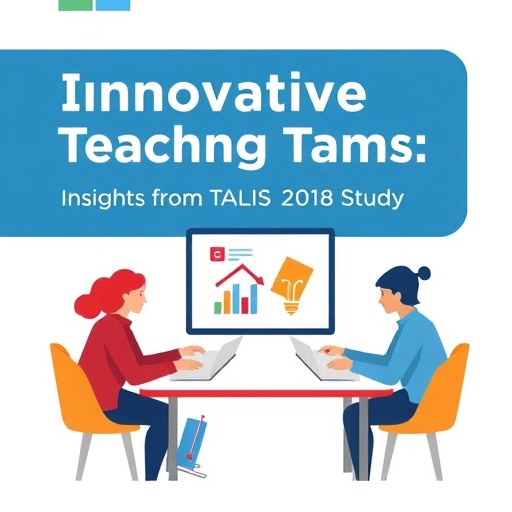In an era where educational paradigms are shifting and where innovative teaching methodologies are being emphasized, the focus on teachers’ collaborative efforts in nurturing creativity and adaptability cannot be overlooked. A recent study, rooted in the 2018 Teaching and Learning International Survey (TALIS), dives deep into the dynamics of teachers’ team innovativeness. Conducted by researchers Koo and Yoo, this groundbreaking research utilizes advanced statistical methodologies, including glmmLasso, to analyze how collaborative teaching environments can significantly influence teachers’ ability to innovate and adapt in their classrooms.
The study’s findings shed light on the necessity for educational institutions to promote team-based frameworks that empower teachers. This is not merely wishful thinking but is supported by a robust empirical analysis that reveals how collective efforts among educators lead to enhanced innovative practices. In this comprehensive study, Koo and Yoo tackle the entrenched issues related to traditional educational frameworks, advocating for a paradigm shift that prioritizes collaboration and collective creativity among teachers.
One of the primary aspects explored in the study is how team innovativeness can act as a catalyst for enhancing teaching quality. Through multilevel data analyses, the authors demonstrate that teachers who engage regularly in collaborative projects are more likely to implement innovative teaching strategies. This highlights the importance of fostering a culture that not only values individual accomplishments but also emphasizes the significant impact of teamwork in developing new educational methodologies.
The research underscores that the essence of educational innovation lies not solely in the individual genius of teachers but in their ability to work synergistically. By employing the glmmLasso method, Koo and Yoo provide a nuanced understanding of the interactions between individual traits and group dynamics. Their approach reveals that the most successful teaching environments are those where educators encourage one another to think outside the box and explore uncharted pedagogical territories.
What is particularly compelling about the study is its empirical basis; the researchers utilized real-world data collected from the TALIS 2018 dataset, which encompasses responses from countless educators across multiple countries. This robustness enhances the validity of their findings, suggesting that the phenomenon of team innovativeness is not limited to specific locales or educational systems but is, in fact, a global trend. The implications of these findings resonate strongly across diverse educational settings, calling on policymakers and institutions to rethink the structures that currently govern teaching practices.
Moreover, the findings suggest that professional development programs should increasingly integrate collaborative training sessions. By doing so, educational institutions can better equip teachers to work effectively in teams, sharing insights and strategies that can lead to innovative practices. This is a clarion call for educational leaders to invest in collaborative professional development as a cornerstone of teacher training, ultimately leading to improved student outcomes.
The significance of this research extends beyond just enhancing teaching methods. The study also raises critical questions about the current evaluation measures employed in educational institutions. Traditional metrics often focus on individual teacher performance, thereby overlooking the collaborative efforts that may yield significant advancements in pedagogical techniques. Koo and Yoo’s analysis underscores the necessity for a shift towards more holistic evaluation systems that recognize the value of teamwork.
In an educational landscape increasingly influenced by technological advancements and global challenges, fostering teacher team innovativeness emerges as a strategic necessity. As classrooms evolve to accommodate diverse learners and digital resources, the collaborative efforts of educators will be paramount in ensuring that students are adequately prepared for the complexities of the 21st century. Thus, educators must be encouraged to innovate collectively rather than in isolation, paving the way for richer student experiences and deeper learning.
Additionally, the study contributes to the broader dialogue surrounding the role of collaborative initiatives in mitigating educational inequities. By promoting teamwork among teachers, schools can create more inclusive environments that harness diverse perspectives and approaches. This not only benefits the educators themselves but ultimately enriches the learning experiences of students, particularly those from marginalized backgrounds.
Koo and Yoo’s investigation into teachers’ team innovativeness also has implications for future research. As educational contexts continue to shift and adapt, it will be essential for researchers to explore new collaborative frameworks that can further enhance teaching efficacy. Studies that extend the current findings into unexplored regions or diverse educational settings could provide invaluable insights that reshape how educators approach innovation in the classroom.
In conclusion, the implications of this study resonate far beyond the immediate findings. As educational institutions grapple with the demands of modern teaching, the emphasis on teachers’ team innovativeness presents a timely solution. Koo and Yoo’s research contributes significantly to our understanding of how collaborative efforts can transform educational practices, calling on institutions to create environments that foster teamwork and creativity. By prioritizing collaboration, educational leaders can shape the future of teaching and learning, ensuring that they meet the challenges of a rapidly changing world.
The necessity for educational reform is clear, and as this study illustrates, fostering a culture of innovation among teachers is a critical step toward achieving that goal. With the right support and institutional changes, the potential for teachers to innovate within collaborative frameworks appears limitless.
Subject of Research: Teachers’ team innovativeness and its impact on educational practices.
Article Title: Teachers’ team innovativeness in TALIS 2018: An empirical and simulation study using glmmLasso for multilevel data.
Article References: Koo, M., Yoo, J. Teachers’ team innovativeness in TALIS 2018: An empirical and simulation study using glmmLasso for multilevel data. Large-scale Assess Educ 13, 19 (2025). https://doi.org/10.1186/s40536-025-00254-x
Image Credits: AI Generated
DOI: 10.1186/s40536-025-00254-x
Keywords: Teachers, team innovativeness, collaborative teaching, TALIS 2018, glmmLasso, educational practices, professional development, educational reform.




